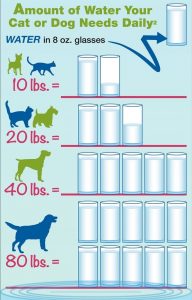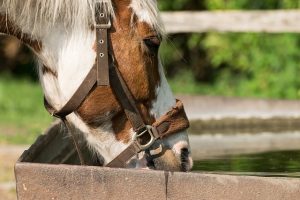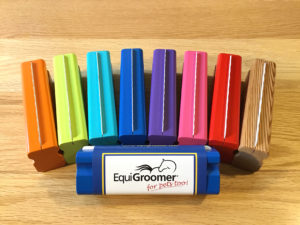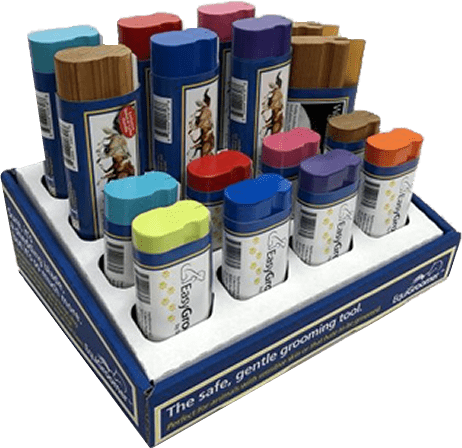As the summer months heat up, people become more conscious about staying cool and fully hydrated. But did you know your pet is at an even greater risk of dehydration? Learn how to keep pets well-hydrated during the summer months below!
 Yes, our pets are at an even greater risk for dehydration because their bodies contain more water (80%) than the human body which contains only 60% of water so it’s critical to know how to keep your pets well-hydrated during the summer months.
Yes, our pets are at an even greater risk for dehydration because their bodies contain more water (80%) than the human body which contains only 60% of water so it’s critical to know how to keep your pets well-hydrated during the summer months.
So, in honor of National Pet Hydration Awareness Month during July, let’s take a closer look below at the proper hydration our pets need in these hotter months.
How Much Water Do Pets Need?

Most pets need 1 ounce of water per 1 pound of bodyweight. (Learn about how much water horses need below.) Is your pet getting that much water each day? All pets need plenty of fresh, cool water, especially during the hotter months.
Closely monitor their water intake to ensure they are getting enough water to support their overall health.
If your pet likes to drink out of the faucet (including some cats), invest in a pet fountain that offers fresh running water to entice them to drink more.
This handy graphic by PetSafe.net, the founders behind National Pet Hydration Awareness Month, offers a great visual in terms of 8 oz. glasses of water. (Exercise or excessive heat/humidity increases how much water your pet needs.)
Unfortunately, most pets do not get enough hydration during extreme and humid temperatures. Even if your pet is indoors in the air conditioning, their bodies still feel the effects of the increased heat and humidity especially if they spend any time outdoors.
Signs of Dehydration
Dehydration can sneak up on your pet and owners need to be aware of the symptoms indicating potential dehydration.
symptoms indicating potential dehydration.
- Sunken, dry eyes
- Dry nose and/or mouth
- Lethargy and depression
- Gums that are dry, sticky or pale
- Loss of appetite or refusal to eat
Use this Skin Test to See If Your Pet is Dehydrated
Gently pull up a loose fold of skin from the back of your pet’s neck or in between their shoulder blades.
Release.
If the skin quickly returns to normal, your pet is probably ok. If the skin hesitates or slowly returns to normal, your pet could be showing signs of dehydration. Call or see your veterinarian immediately to rule out dehydration and other serious health consequences.
Dehydration: Other Causes
Dogs or cats with the health conditions below can become dehydrated quicker and easier and need to be monitored closely.
quicker and easier and need to be monitored closely.
- Vomiting or diarrhea
- Fever
- Trauma
- Heatstroke
- Kidney disease
- Diabetes (or other metabolic disorder)
- Cancer
- Pets who are pregnant/nursing
Dehydration: Equine
 Horses are just as susceptible to dehydration. Just a 3-4% loss of body water can cause mild dehydration in a horse.
Horses are just as susceptible to dehydration. Just a 3-4% loss of body water can cause mild dehydration in a horse.
Horses who exercise and sweat in hot, humid temperatures will need more water especially to avoid heat exhaustion/heat stroke and worse.
According to the EquiMed website, adult horses around 1,000 pounds require a minimum of 10-12 gallons of water each day. Just like with other pets, water is critical for an equine’s proper bodily functions.
The Skin Test (above) can also be used near the base of the horse’s neck to help determine dehydration.
Always work with your veterinarian to make sure that you keep pets well-hydrated during the summer months to avoid any potential risks to their health.
water each day, help your
animals stay as cool as possible
with regular grooming to remove
excess, dead hair.
Our EquiGroomer tools make grooming your horse easier, stress-free AND pain-free!
Order individual EquiGroomer tools or professional kits for your pet shop, tack shop or barn, by calling 860-573-0604, sending us an email or visiting our website today!
Additional Reading:
PetSafe: Pet Hydration Awareness Month, Why Now
PetSafe: Infographic: Does Your Pet Have a Drinking Problem?
PetMD: The Importance of Water for Dog Nutrition
PetMD: Dehydration in Cats
EquiMed: Dehydration
Horse Racing Sense: Is My Horse Dehydrated? 10 Clear Signs of Equine Dehydration
Image Credits (In Order of Appearance):
Rebecca Schönbrodt-Rühl from Pixabay
Product Image Courtesy of EquiGroomer


